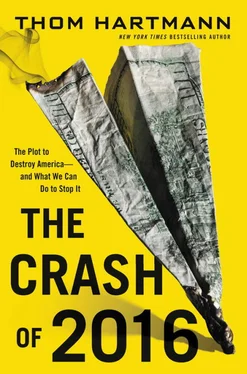If you type “solar power rooftop shingles” into a search engine, over three million hits come back. At the top is a 2010 video review that Consumer Reports did of Dow’s new “Powerhouse Solar Shingles,” which the company was just then rolling out. They require no wires or wiring—and so can be installed by a normal roofer using normal roofing nails. They look pretty much like asphalt shingles, and protect the roof of the house the same or better. And they can generate “from forty to sixty percent” of all the electricity a home needs (and that’s assuming the home hasn’t been superinsulated and appliances haven’t been upgraded to low-power-consumption types).
At the moment, according to Consumer Reports , it costs about $25,000 to cover your roof with Dow’s new photovoltaic shingles, but federal tax advantages can cut that price by a third, and state tax incentives can drop it even further.
Meanwhile, a new technology was announced in late 2011 that allows solar-electric-generating panels to be created using an ink-jet printing technique to apply the light-catching/electricity-producing material, rather than the now-current “gas diffusion” method, which requires large machines, lots of heat, and wastes much of the material. The cost of solar panels is dropping like a stone, pretty much following Moore’s Law—every year or two the price drops by half, while the capability doubles. As of this writing, solar panels are competitive with any other form of electricity generation, and far cheaper than coal or nuclear when you monetize the externalities such as fly ash, smoke/mercury, and nuclear waste. Wind is even cheaper. Both solar and wind will become so inexpensive soon—perhaps even by the time you read these words—that the tipping point will have been reached and most all of the investment, development, and research money and effort will be there.
As will people’s homes.
Just as America now faces an unsustainable thirst for energy, so, too, was Germany faced with a power crisis in the late 1990s. Growing demands for electricity collided with the reality that the country has no oil reserves and a strong bias among its people against building new nuclear power plants in the wake of the nearby Chernobyl meltdown.
Yet the government knew that the country needed the electricity equivalent of at least one or two nuclear power plants over the next decade. So, how to generate that much electricity without nuclear power?
In 1999, progressives in Germany passed the 100,000 Roofs Program, 189which mandated that banks had to provide low-interest ten-year loans to homeowners sufficient for them to put solar panels on their houses. They then passed the Renewable Energy Law and integrated the 100,000 Roofs Program into it in 2004. 190The REL mandated that for the next ten years, the power company had to buy power back from those homeowners at a level substantially above the going rate so that the homeowners’ income from the solar panels would equal their loan payment on the panels and would also represent the actual cost to the power company to generate that amount of power by building a new nuclear power plant.
At the end of the ten years, the power company gets to buy solar power at its regular rate, and it now has a new source of power without having to pay to maintain (and eventually dismantle) a nuclear reactor. In fact, while the reactor would have a twenty-to-thirty-year life span, the solar panels typically last fifty years.
For the homeowners, it was a no-brainer: They were getting low-interest loans from banks for the solar panels, and the power companies were paying for the power generated from those panels at a rate high enough to pay off the loans. It was like getting solar-power panels for free.
If anything, the government underestimated how rapidly Germans would embrace the program, and thus how much power would be produced by the program, and how quickly. By 2007, Germany accounted for about half of the entire world’s solar market. Just that one year, 2007, saw 1,300 megawatts (millions of watts) of solar-generating capacity brought on line across the country. 191
For comparison, consider that the average generating capacity of each of the last five nuclear power plants brought on line in the United States is 1,160 megawatts. 192
In 2008, Germany added 2,000 megawatts of solar power to their grid, and in 2009 homeowners and businesses put onto their roofs enough solar panels to glean an additional 2,500 megawatts. Although the goal for the first decade of this century was to generate around 3,000 megawatts, eliminating the need to build two new nuclear power plants, this simple, no-risk program had instead added over 8,500 megawatts of power.
And, because the generation sources were scattered across the country, there was no need to run new high-tension power lines from central generating stations, making it more efficient and less expensive. Meanwhile, as dozens of German companies got into the business of manufacturing and installing solar-power systems, the cost dropped by more than half between 1997 and 2007, and continues to plummet. 193
The Germans expect that by 2050 more than a quarter of all their electricity will come from solar (it’s now just over 1 percent), adding to the roughly 12.5 percent of all German energy currently being produced by renewable energy sources (mostly hydro, but also including wind, biomass, and geothermal). 194
The solar-panel program has been so successful that the German government is now thinking that it’s time to back off and leave this to the marketplace. As the New York Times noted in May 2008:
Thanks to its aggressive push into renewable energies, cloud-wreathed Germany has become an unlikely leader in the race to harness the sun’s energy. It has by far the largest market for photovoltaic systems, which convert sunlight into electricity, with roughly half of the world’s total installations…
Now, though, with so many solar panels on so many rooftops, critics say Germany has too much of a good thing—even in a time of record oil prices. Conservative lawmakers, in particular, want to pare back generous government incentives that support solar development. They say solar generation is growing so fast that it threatens to overburden consumers with high electricity bills. 195
Translation: The solar-panel manufacturers want the subsidies to stop so they can catch up with demand and then bump up the price, and profits. Because of the subsidies, prices have been dropping faster than manufacturing costs.
Germany is now considering incentives to its world-famous domestic auto industry to manufacture flex-fuel plug-in hybrid automobiles that can get over 500 miles per gallon of (strategic) gasoline (boosted by domestically produced rooftop solar) with existing technology.
Meanwhile, Denmark has invested billions into having more than half of its entire auto fleet using only electricity by 2030.
And China is no slouch when it comes to renewable energy. Although the Chinese continue to bring another dirty coal-fired power plant on line about once a week, they surpassed every other nation in the world in 2010 in direct investment in the production of solar and wind power. As the Los Angeles Times reported in March 2010:
U.S. clean energy investments hit $18.6 billion last year, a report from the Pew Charitable Trusts said, a little more than half the Chinese total of $34.6 billion. Five years ago, China’s investments in clean energy totaled just $2.5 billion. The United States also slipped behind 10 other countries, including Canada and Mexico, in clean energy investments as a share of the national economy…
[T]he Pew report pointed to another factor constraining U.S. competitiveness: a lack of national mandates for renewable energy production or a surcharge on greenhouse gas emissions that would make fossil fuels more expensive. 196
Читать дальше












